Yilong Chen
Blink: Dynamic Visual Token Resolution for Enhanced Multimodal Understanding
Dec 11, 2025Abstract:Multimodal large language models (MLLMs) have achieved remarkable progress on various vision-language tasks, yet their visual perception remains limited. Humans, in comparison, perceive complex scenes efficiently by dynamically scanning and focusing on salient regions in a sequential "blink-like" process. Motivated by this strategy, we first investigate whether MLLMs exhibit similar behavior. Our pilot analysis reveals that MLLMs naturally attend to different visual regions across layers and that selectively allocating more computation to salient tokens can enhance visual perception. Building on this insight, we propose Blink, a dynamic visual token resolution framework that emulates the human-inspired process within a single forward pass. Specifically, Blink includes two modules: saliency-guided scanning and dynamic token resolution. It first estimates the saliency of visual tokens in each layer based on the attention map, and extends important tokens through a plug-and-play token super-resolution (TokenSR) module. In the next layer, it drops the extended tokens when they lose focus. This dynamic mechanism balances broad exploration and fine-grained focus, thereby enhancing visual perception adaptively and efficiently. Extensive experiments validate Blink, demonstrating its effectiveness in enhancing visual perception and multimodal understanding.
Intelligent Reflecting Surfaces for Integrated Sensing and Communications: A Survey
Nov 14, 2025Abstract:The rapid development of sixth-generation (6G) wireless networks requires seamless integration of communication and sensing to support ubiquitous intelligence and real-time, high-reliability applications. Integrated sensing and communication (ISAC) has emerged as a key solution for achieving this convergence, offering joint utilization of spectral, hardware, and computing resources. However, realizing high-performance ISAC remains challenging due to environmental line-of-sight (LoS) blockage, limited spatial resolution, and the inherent coverage asymmetry and resource coupling between sensing and communication. Intelligent reflecting surfaces (IRSs), featuring low-cost, energy-efficient, and programmable electromagnetic reconfiguration, provide a promising solution to overcome these limitations. This article presents a comprehensive overview of IRS-aided wireless sensing and ISAC technologies, including IRS architectures, target detection and estimation techniques, beamforming designs, and performance metrics. It further explores IRS-enabled new opportunities for more efficient performance balancing, coexistence, and networking in ISAC systems, focuses on current design bottlenecks, and outlines future research directions. This article aims to offer a unified design framework that guides the development of practical and scalable IRS-aided ISAC systems for the next-generation wireless network.
StreamKV: Streaming Video Question-Answering with Segment-based KV Cache Retrieval and Compression
Nov 10, 2025Abstract:Video Large Language Models (Video-LLMs) have demonstrated significant potential in the areas of video captioning, search, and summarization. However, current Video-LLMs still face challenges with long real-world videos. Recent methods have introduced a retrieval mechanism that retrieves query-relevant KV caches for question answering, enhancing the efficiency and accuracy of long real-world videos. However, the compression and retrieval of KV caches are still not fully explored. In this paper, we propose \textbf{StreamKV}, a training-free framework that seamlessly equips Video-LLMs with advanced KV cache retrieval and compression. Compared to previous methods that used uniform partitioning, StreamKV dynamically partitions video streams into semantic segments, which better preserves semantic information. For KV cache retrieval, StreamKV calculates a summary vector for each segment to retain segment-level information essential for retrieval. For KV cache compression, StreamKV introduces a guidance prompt designed to capture the key semantic elements within each segment, ensuring only the most informative KV caches are retained for answering questions. Moreover, StreamKV unifies KV cache retrieval and compression within a single module, performing both in a layer-adaptive manner, thereby further improving the effectiveness of streaming video question answering. Extensive experiments on public StreamingVQA benchmarks demonstrate that StreamKV significantly outperforms existing Online Video-LLMs, achieving superior accuracy while substantially improving both memory efficiency and computational latency. The code has been released at https://github.com/sou1p0wer/StreamKV.
Environment-Aware IRS Deployment via Channel Knowledge Map: Joint Sensing-Communications Coverage Optimization
Sep 05, 2025Abstract:This paper studies the intelligent reflecting surface (IRS) deployment optimization problem for IRS-enabled integrated sensing and communications (ISAC) systems, in which multiple IRSs are strategically deployed at candidate locations to assist a base station (BS) to enhance the coverage of both sensing and communications. We present an environment-aware IRS deployment design via exploiting the channel knowledge map (CKM), which provides the channel state information (CSI) between each candidate IRS location and BS or targeted sensing/communication points. Based on the obtained CSI from CKM, we optimize the deployment of IRSs, jointly with the BS's transmit beamforming and IRSs' reflective beamforming during operation, with the objective of minimizing the system cost, while guaranteeing the minimum illumination power requirements at sensing areas and the minimum signal-to-noise ratio (SNR) requirements at communication areas. In particular, we consider two cases when the IRSs' reflective beamforming optimization can be implemented dynamically in real time and quasi-stationarily over the whole operation period, respectively. For both cases, the joint IRS deployment and transmit/reflective beamforming designs are formulated as mixed-integer non-convex optimization problems, which are solved via the successive convex approximation (SCA)-based relax-and-bound method. Specifically, we first relax the binary IRS deployment indicators into continuous variables, then find converged solutions via SCA, and finally round relaxed indicators back to binary values. Numerical results demonstrate the effectiveness of our proposed algorithms in reducing the system cost while meeting the sensing and communication requirements.
Advantageous Parameter Expansion Training Makes Better Large Language Models
May 30, 2025
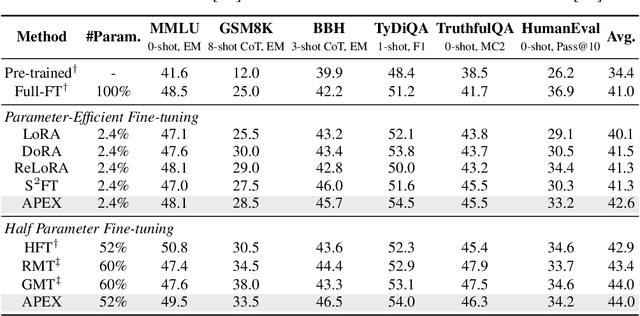
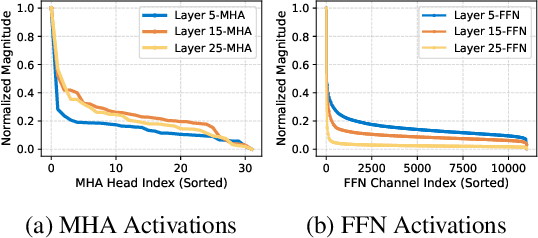
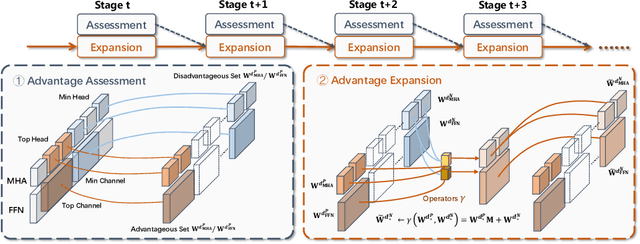
Abstract:Although scaling up the number of trainable parameters in both pre-training and fine-tuning can effectively improve the performance of large language models, it also leads to increased computational overhead. When delving into the parameter difference, we find that a subset of parameters, termed advantageous parameters, plays a crucial role in determining model performance. Further analysis reveals that stronger models tend to possess more such parameters. In this paper, we propose Advantageous Parameter EXpansion Training (APEX), a method that progressively expands advantageous parameters into the space of disadvantageous ones, thereby increasing their proportion and enhancing training effectiveness. Further theoretical analysis from the perspective of matrix effective rank explains the performance gains of APEX. Extensive experiments on both instruction tuning and continued pre-training demonstrate that, in instruction tuning, APEX outperforms full-parameter tuning while using only 52% of the trainable parameters. In continued pre-training, APEX achieves the same perplexity level as conventional training with just 33% of the training data, and yields significant improvements on downstream tasks.
Inner Thinking Transformer: Leveraging Dynamic Depth Scaling to Foster Adaptive Internal Thinking
Feb 19, 2025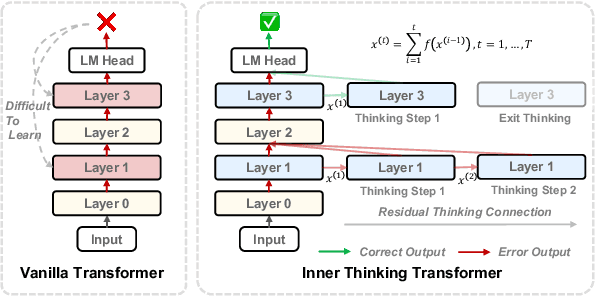
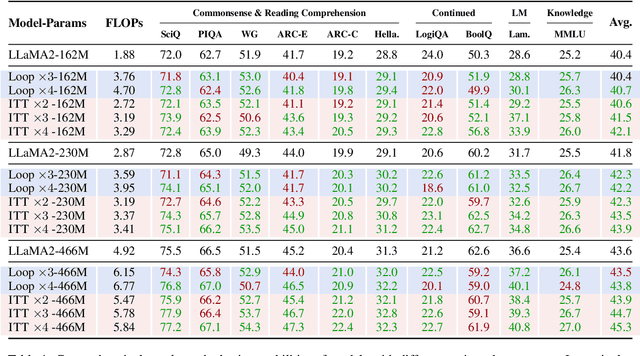
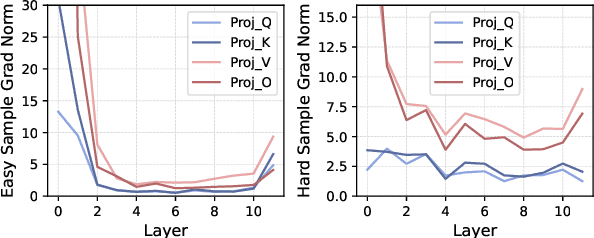
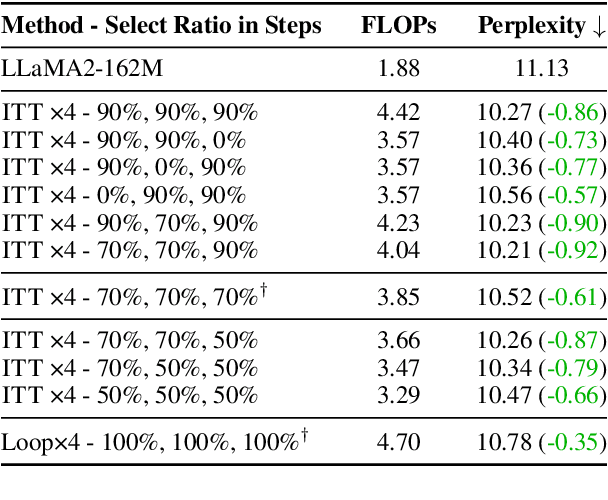
Abstract:Large language models (LLMs) face inherent performance bottlenecks under parameter constraints, particularly in processing critical tokens that demand complex reasoning. Empirical analysis reveals challenging tokens induce abrupt gradient spikes across layers, exposing architectural stress points in standard Transformers. Building on this insight, we propose Inner Thinking Transformer (ITT), which reimagines layer computations as implicit thinking steps. ITT dynamically allocates computation through Adaptive Token Routing, iteratively refines representations via Residual Thinking Connections, and distinguishes reasoning phases using Thinking Step Encoding. ITT enables deeper processing of critical tokens without parameter expansion. Evaluations across 162M-466M parameter models show ITT achieves 96.5\% performance of a 466M Transformer using only 162M parameters, reduces training data by 43.2\%, and outperforms Transformer/Loop variants in 11 benchmarks. By enabling elastic computation allocation during inference, ITT balances performance and efficiency through architecture-aware optimization of implicit thinking pathways.
Mixture of Hidden-Dimensions Transformer
Dec 10, 2024



Abstract:Transformer models encounter challenges in scaling hidden dimensions efficiently, as uniformly increasing them inflates computational and memory costs while failing to emphasize the most relevant features for each token. For further understanding, we study hidden dimension sparsity and observe that trained Transformers utilize only a small fraction of token dimensions, revealing an "activation flow" pattern. Notably, there are shared sub-dimensions with sustained activation across multiple consecutive tokens and specialized sub-dimensions uniquely activated for each token. To better model token-relevant sub-dimensions, we propose MoHD (Mixture of Hidden Dimensions), a sparse conditional activation architecture. Particularly, MoHD employs shared sub-dimensions for common token features and a routing mechanism to dynamically activate specialized sub-dimensions. To mitigate potential information loss from sparsity, we design activation scaling and group fusion mechanisms to preserve activation flow. In this way, MoHD expands hidden dimensions with negligible increases in computation or parameters, efficient training and inference while maintaining performance. Evaluations across 10 NLP tasks show that MoHD surpasses Vanilla Transformers in parameter efficiency and task performance. It achieves 1.7% higher performance with 50% fewer activation parameters and 3.7% higher performance with a 3x parameter expansion at constant activation cost. MOHD offers a new perspective for scaling the model, showcasing the potential of hidden dimension sparsity to boost efficiency
On-Road Object Importance Estimation: A New Dataset and A Model with Multi-Fold Top-Down Guidance
Nov 26, 2024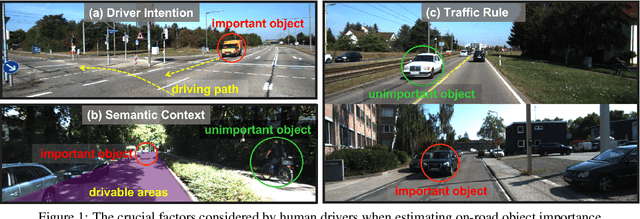

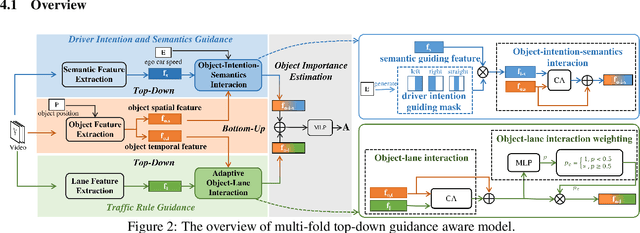

Abstract:This paper addresses the problem of on-road object importance estimation, which utilizes video sequences captured from the driver's perspective as the input. Although this problem is significant for safer and smarter driving systems, the exploration of this problem remains limited. On one hand, publicly-available large-scale datasets are scarce in the community. To address this dilemma, this paper contributes a new large-scale dataset named Traffic Object Importance (TOI). On the other hand, existing methods often only consider either bottom-up feature or single-fold guidance, leading to limitations in handling highly dynamic and diverse traffic scenarios. Different from existing methods, this paper proposes a model that integrates multi-fold top-down guidance with the bottom-up feature. Specifically, three kinds of top-down guidance factors (ie, driver intention, semantic context, and traffic rule) are integrated into our model. These factors are important for object importance estimation, but none of the existing methods simultaneously consider them. To our knowledge, this paper proposes the first on-road object importance estimation model that fuses multi-fold top-down guidance factors with bottom-up feature. Extensive experiments demonstrate that our model outperforms state-of-the-art methods by large margins, achieving 23.1% Average Precision (AP) improvement compared with the recently proposed model (ie, Goal).
MoR: Mixture of Ranks for Low-Rank Adaptation Tuning
Oct 17, 2024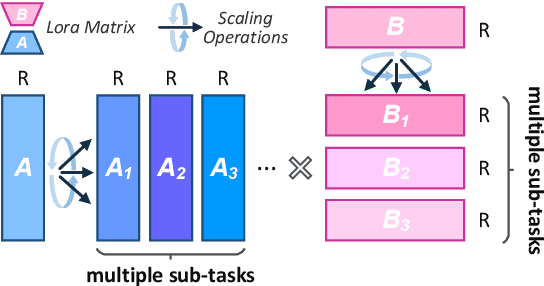
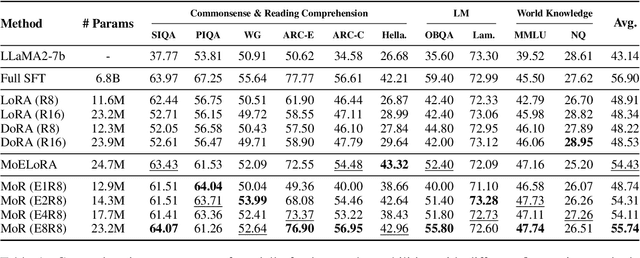

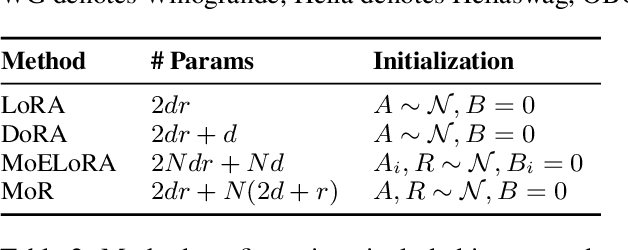
Abstract:Low-Rank Adaptation (LoRA) drives research to align its performance with full fine-tuning. However, significant challenges remain: (1) Simply increasing the rank size of LoRA does not effectively capture high-rank information, which leads to a performance bottleneck.(2) MoE-style LoRA methods substantially increase parameters and inference latency, contradicting the goals of efficient fine-tuning and ease of application. To address these challenges, we introduce Mixture of Ranks (MoR), which learns rank-specific information for different tasks based on input and efficiently integrates multi-rank information. We firstly propose a new framework that equates the integration of multiple LoRAs to expanding the rank of LoRA. Moreover, we hypothesize that low-rank LoRA already captures sufficient intrinsic information, and MoR can derive high-rank information through mathematical transformations of the low-rank components. Thus, MoR can reduces the learning difficulty of LoRA and enhances its multi-task capabilities. MoR achieves impressive results, with MoR delivering a 1.31\% performance improvement while using only 93.93\% of the parameters compared to baseline methods.
Exploiting Moving Arrays for Near-Field Sensing
Oct 12, 2024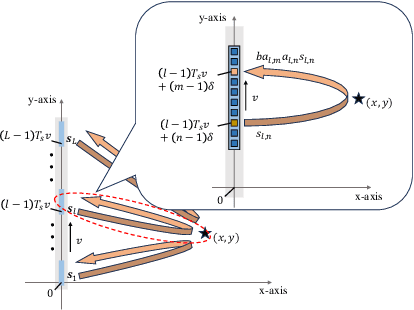



Abstract:This letter exploits moving arrays to enable nearfield multiple-input multiple-output (MIMO) sensing via a limited number of antenna elements. We consider a scenario where a base station (BS) is equipped with a uniform linear array (ULA) on a moving platform. The objective is to locate a point target in the two-dimensional (2D) space by leveraging the near-field channel characteristics created by the movement of antenna arrays. Under this setup, we analyze the Cramer-Rao bound (CRB) for estimating the target's 2D coordinate, which provides the fundamental sensing performance limits for localization. It is revealed that our proposed design with a moving array achieves a CRB that is proportional to the CRB obtained by an equivalent extremely large ULA matching the platform's size. This shows that the movement of antenna array significantly enlarges its effective aperture to enable near-field sensing. Numerical results show that the proposed moving array design substantially enhances the target estimation performance compared to the conventional fixed array benchmark.
 Add to Chrome
Add to Chrome Add to Firefox
Add to Firefox Add to Edge
Add to Edge